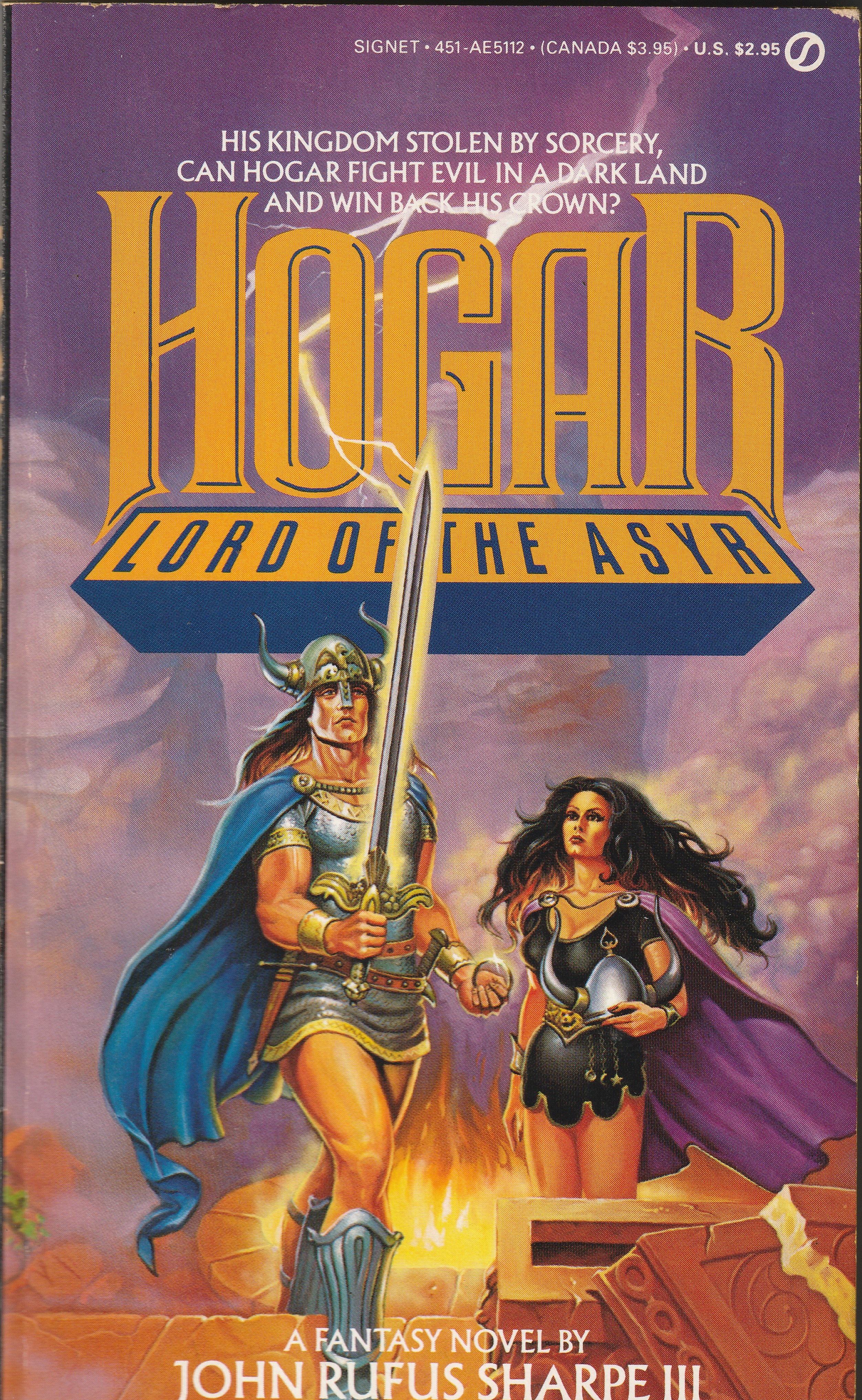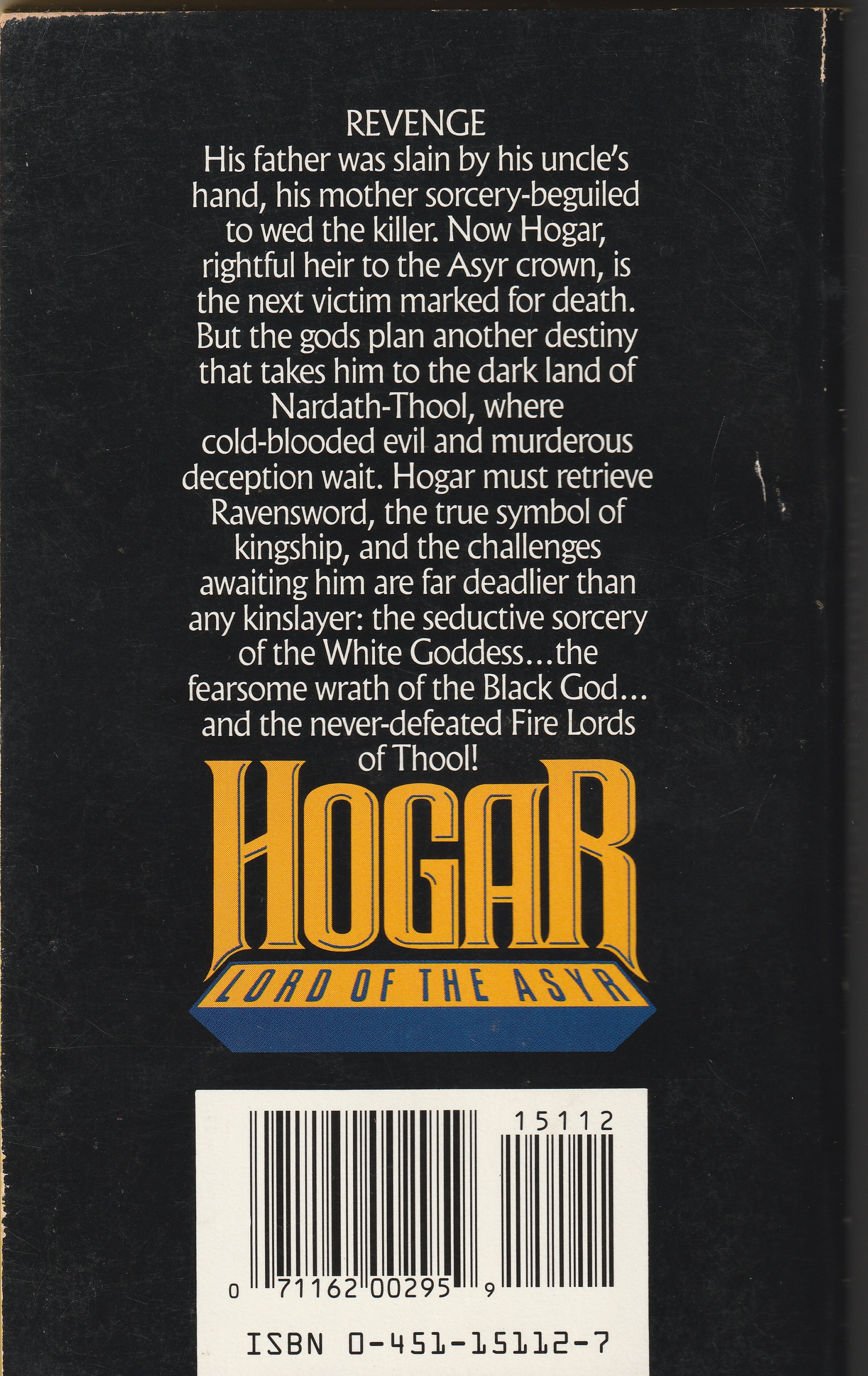 Hogar, Lord of the Asyr by John Rufus Shapre III is an odd book for more than one reason. I will get into that. This is a paperback from Signet/New American Library from December 1987.
Hogar, Lord of the Asyr by John Rufus Shapre III is an odd book for more than one reason. I will get into that. This is a paperback from Signet/New American Library from December 1987.
The novel has a foreword of three pages describing Hogar’s antediluvian world. I found it confusing and had to reread it several times (slowly) to get it.
Hogar is a proto-Norse type nephew of Jarl Hothir, brother to the king of Nordland. He is thrown in prison after a (set-up) fight. A price is set on his head from his uncle who proclaims himself king after his brother dies.
There are a series of adventures and misadventures. A prophecy of great deeds, meeting of comrades, and a quest to recover an important sword and the Ring of Odin from a city of sorcerers.
The ending is rather gonzo with the novel clocking out at 223 pages. Plus there is a glossary!
First: the cover. No artist is listed. It looks like 1980s Ken Kelly with the colors and static character poses. It is glossier than Kelly though and you generally see his signature. Who did the cover?
Second: Who is John Rufus Sharpe III. He was Jack Sharpe known for songwriting and a music publishing executive. He was born in 1909 and died 1996. That makes him from the same age group as Robert E. Howard, Derleth, Wandrei, Williamson. This would be like having a new novel from Robert E. Howard in 1984!
Third: Timing. I remember seeing this book on the bookshelves at Waldenbooks or B. Dalton Bookseller at the time. Sword & sorcery fiction had been in decline for a few years. I was aware of it in 1985 when I could detect the genre was being purged. The whole packaging struck me as being more appropriate to 1977 than 1987.
This novel meandered around with more incidents than was needed. When you first start reading, you think, this is a sword and sorcery take on Hamlet. Actually not a bad place to go. But the narrative got lost in the weeds. You see the influence of Robert E. Howard with a mini-Hyborian type foreword. Sharpe borrows from Norse and Irish mythology for the set up, mainly using exotic sounding names. The novel takes a turn into Lin Carter territory with the quest to city of Nardath-Thool. There is an arena scene that is either from Edgar Rice Burroughs or Lin Carter. There is even an air-ship at the end.
Sharpe’s prose is unique. He uses forgotten words like reeve or bairn. The dialogue does not descend to Gardner F. Fox barbarian speak. I noted a few sentences or phrases that could have been better but Sharpe’s prose could have been far worse. To much time was taken in the set-up while the conclusion was rushed if not frenzied.
My guess is John Rufus Sharpe read Edgar Rice Burroughs and Weird Tales in the 1930s. Hogar, Lord of the Asyr is post-pulp in execution and prose. This is not some lost gem but an oddity. You see the influences a mile away but age has allowed me to note some of the prose idiosyncrasies of the book. It is like a Thongor novel that went on for too long. Lin Carter had his faults but he generally kept the narrative from rambling.
Sharpe never wrote anything else. He was getting up there in age when Hogar came out. There was only one printing. I would love to know the details of how this novel even got green lighted at the time it did. Don’t go out on a quest to track this novel down, especially if you have not read more important novels in the history of sword and sorcery. But, if you come across it cheap and you are bored and have read everything else, caveat emptor. Another forgotten fantasy novel from the 1980s.

“Bairn” is forgotten, you say? Northern Englanders would beg to differ.